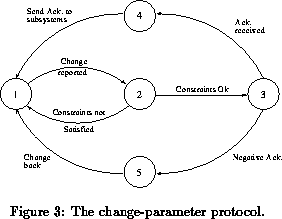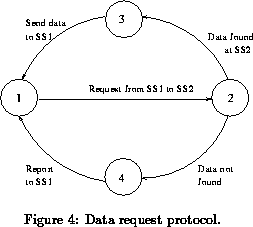


Next: Prototyping Environment Database
Up: The Prototyping Environment
Previous: Overall Design

The main purpose of this environment is to keep all the subsystems
informed of any changes in the design parameters. Therefore, passing
information between the subsystems is the most important part of this
environment. To be able to control the information flow,
some protocols were developed to enable the communication between these
subsystems in an organized manner. In our design, all subsystems
communicate through the CI which is responsible for passing the
information to the subsystems that need to know.
There are two types of events that can occur in this system:
- Change reported from one of the subsystems.
- Request for data from one subsystem to another.
Figure 3 shows the protocol used for the first
event represented by a finite state machine (FSM). The states of this
FSM are:
- Steady state: Do nothing.
- Change has been reported: send lock message to all
subsystems. Apply relations and check constraints. If constraints are
satisfied, go to state 3. If constraints are not satisfied, report these to
sender and go to steady state.
- Constraints are satisfied: Notify the subsystems with the
changes and wait for acknowledgments.
- Acknowledgments received from all subsystems: Send the final
acknowledgment to the subsystems and go to steady state.
- Acknowledgments not Ok: Send a ``change-back'' command to the
subsystems and go to steady state.
Figure 4 shows the protocol for the second event.
The states in this FSM are:
- Steady state: Do nothing.
- Request for SS2 received from SS1. Send the request to SS2.
- Required data found at SS2. Send data to SS1 and go to steady state.
- Required data not found at SS2. Send report to SS1 and go to
steady state.





